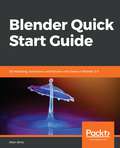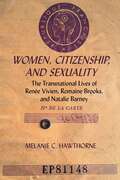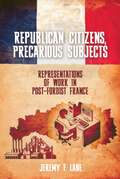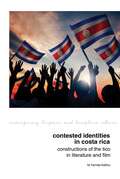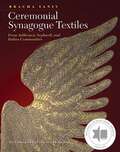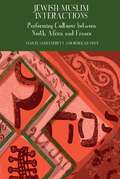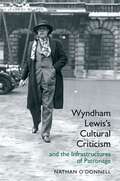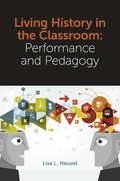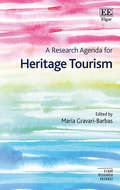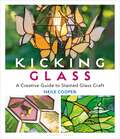- Table View
- List View
Getting Started with SketchUp Pro: Embark on your 3D modeling adventure with expert tips, tricks, and best practices
by David S. SellersOwing to its ability to create models quickly and with high level of dimensional accuracy, SketchUp Pro has become a popular choice for many industries, including architecture, interior design, landscape architecture, and video game design. If you are seeking to adopt Trimble's exceptional design software, Getting Started with SketchUp Pro serves as an ideal primer to prepare and equip you for its use. This book will help you lay the foundation of a project from scratch, set up appropriate units, and follow a guided path to structure your 3D models. You’ll explore the workflows used for creating designs from sketches, making CAD drawings (DWG), and even updating your existing 3D models. Finally, you’ll work with extensions and 3D Warehouse to find new workflows and models to add to your skill set. By the end of this SketchUp book, you’ll be able to confidently create and share models of your design through CAD drawings and 3D views, and even take them online through the 3D WarehouseKey FeaturesPut your architectural design knowledge to work by exploring practical examplesGain a deeper understanding of SketchUp's GUI, modeling tools, and editing featuresExecute full design creations with detailed steps without getting overwhelmed by SketchUp's advanced functionalitiesWhat you will learnBuild massing 3D models and preliminary designsIdentify optimal methods to boost productivity and efficiency with SketchUp ProExplore SketchUp tools and understand their diverse functionalityGet a complete walkthrough of editing tools, materials, and components in SketchUpCreate and edit components and explore component optionsGet acquainted with SketchUp extensions, 3D Warehouse, and additional tools and resourcesWho this book is forThis book is for architects, landscape architects, interior designers, woodworkers, and 3D modelers with beginner-level knowledge of the architectural design of living spaces. Basic computer skills are all you need to get started.
Blender Quick Start Guide: 3d Modeling, Animation, And Render With Eevee In Blender 2. 8
by Allan BritoThe persistence of memory: Remembering slavery in Liverpool, 'slaving capital of the world' (Liverpool Studies in International Slavery #18)
by Jessica MoodyAn Open Access edition of this book will be made available on publication on our website and on the OAPEN Library, funded by the LUP Open Access Author Fund.The Persistence of Memory is a history of the public memory of transatlantic slavery in the largest slave-trading port city in Europe, from the end of the 18th century into the 21st century; from history to memory. Mapping this public memory over more than two centuries reveals the ways in which dissonant pasts, rather than being ‘forgotten histories’, persist over time as a contested public debate. This public memory, intimately intertwined with constructions of ‘place’ and ‘identity’, has been shaped by legacies of transatlantic slavery itself, as well as other events, contexts and phenomena along its trajectory, revealing the ways in which current narratives and debate around difficult histories have histories of their own. By the 21st century, Liverpool, once the ‘slaving capital of the world’, had more permanent and long-lasting memory work relating to transatlantic slavery than any other British city. The long history of how Liverpool, home to Britain’s oldest continuous black presence, has publicly ‘remembered’ its own slaving past, how this has changed over time and why, is of central significance and relevance to current and ongoing efforts to face contested histories, particularly those surrounding race, slavery and empire.
Women, Citizenship, and Sexuality: The Transnational Lives of Renée Vivien, Romaine Brooks, and Natalie Barney
by Melanie HawthorneUntil well into the twentieth century, the claims to citizenship of women in the US and in Europe have come through men (father, husband); women had no citizenship of their own. The case studies of three expatriate women (Renée Vivien, Romaine Brooks, and Natalie Barney) illustrate some of the consequences for women who lived independent lives. To begin with, the books traces the way that ideas about national belonging shaped gay male identity in the nineteenth century, before showing that such a discourse was not available to women and lesbians, including the three women who form the core of the book. In addition to questions of sexually non-conforming identity, women's mediated claim to citizenship limited their autonomy in practical ways (for example, they could be unilaterally expatriated). Consequently, the situation of the denizen may have been preferable to that of the citizen for women who lived between the lines. Drawing on the discourse of jurisprudence, the history of the passport, and original archival research on all three women, the books tells the story of women's evolving claims to citizenship in their own right.
Republican Citizens, Precarious Subjects: Representations of Work in Post-Fordist France (Studies in Modern and Contemporary France #7)
by Jeremy LaneOver recent decades concerns at the increased scarcity and precarity of salaried employment have dominated political struggles, theoretical debates and cultural representations in France. This study argues that such concerns are evidence of a profound shift in contemporary French economy, culture and society. Engaging with work in political economy and sociology, the book sketches a new interpretative framework, the better to understand the nature and implications of these profound changes. It examines the challenges such changes have posed to fundamental French republican values, arguing they have opened up a rift between older notions of French republican citizenship and the precarious forms of subjectivity characteristic of post-Fordist labour. The book traces the symptoms of this rift in a range of cinematic and literary representations of the contemporary workplace, as these depict the dilemmas faced, the trajectories followed, and the geographical regions inhabited by French workers of different ages, sexes, social classes, and ethnicities.
Contested Identities in Costa Rica: Constructions of the Tico in Literature and Film (Contemporary Hispanic and Lusophone Cultures #20)
by Liz Harvey-KattouCosta Rica is a country known internationally for its eco-credentials, dazzling coastlines, and reputation as one of the happiest and most peaceful nations on earth. Beneath this façade, however, lies an exclusionary rhetoric of nationalism bound up in the concept of the tico, as many Costa Ricans refer to themselves. Beginning by considering the very idea of national identity and what this constitutes, this book explores the nature of the idealised tico identity, demonstrating the ways in which it has assumed a white supremacist, Central Valley-centric, patriarchal, heteronormative stance based on colonial ideals. Chapters two and three then go on to consider the literature and films produced that stand in opposition to this normative image of who or what is tico and their creation as vehicles of soft power which aim to question social norms. This book explores protest literature from the 1970s by Quince Duncan, Carmen Naranjo, and Alfonso Chase who narrate their experiences from the margins of society by virtue of their identity as Afro-Costa Rican, feminist, and homosexual authors. Cinema from the twenty-first century is then analysed to demonstrate the nuanced position chosen by national directors Esteban Ramírez, Paz Fábrega, Jurgen Ureña, and Patricia Velásquez to challenge the dominant nation-image as they reinscribe youth culture, a female consciousness, trans identity, and Afro-Costa Rica onto the fabric of the nation.
The Reclining Nude: Agnès Varda, Catherine Breillat, and Nan Goldin (Contemporary French and Francophone Cultures #65)
by Emma WilsonThe figure of a woman reclining, in repose, displayed, abandoned, fallen, asleep, or dreaming, returns in the work of women filmmakers and photographers in the twentieth and twenty-first centuries. Filmmakers Agnès Varda and Catherine Breillat, and American photographer working in Paris, Nan Goldin, return to the paintings of Titian, Velázquez, Goya, Courbet, and others, re-imagining, and re-purposing, their images of female beauty, display, (auto)eroticism, and intimacy. This book, a sensuous evocation of these feminist works, claims a female-identified pleasure in looking. The artists explored align images of repose and sensuality with other images of horizontality and proneness, of strong emotional content, images of erotic involvement, of vulnerability, of bodily contortion, of listlessness, grief, and depression. The reclining nude is for all three artists a starting point for a reflection on the relation of film, projections, and still photography, to painting, and a sustained re-imagining of the meanings conjured through serial returns to a particular pose. This book claims that the image of the reclining nude is compelling, for female-identified artists – and for all allied in feeling and picturing femininity – in the sensitive, ethically adventurous, politically complex feminist issues it engages. The reclining nude is an image of passivity, of submission, of hedonism. It allows thought about passivity as pleasure, about depression and grief figured posturally, about indolence as a form of resistance and anarchy. Through this image, female-identified artists have claimed freedom to offer new focus on these extremes of emotion. They are re-imagining horizontality.
Image of a Man: The Journal of Keith Vaughan (Liverpool English Texts and Studies #77)
by Alex Belsey‘I want to know what I am, what I want, what I can do, what is real, what is lovely.’ The post-war British artist Keith Vaughan (1912–77) was not only a supremely accomplished painter; he was an impassioned, eloquent writer. Image of a Man is the first book to provide a comprehensive critical reading of Vaughan’s extraordinary journal, which spans thirty-eight years and sixty-one volumes to form a major literary work and a fascinating document of changing times. From close textual analysis of the original manuscripts, this book uncovers the attitudes and arguments that shaped and reshaped Vaughan’s identity as a man and as an artist. It reveals a continual process of self-construction through journal-writing, undertaken to navigate the difficulties of conscientious objection, the complications of desire as a gay man, and the challenges of making meaningful art. By focussing on Vaughan’s journal-writing in the context of its many influences and its centrality to his art practice, Image of a Man offers not only a compelling new critical biography of a significant yet underappreciated artist, but also a sustained argument on the constructed nature of the ‘artist’ persona in early and mid-twentieth-century culture – and the opportunities afforded by journal and diary forms to make such constructions possible.
Inside the invisible: Memorialising Slavery and Freedom in the Life and Works of Lubaina Himid (Liverpool Studies in International Slavery #14)
by Celeste-Marie Bernier Alan Rice Lubaina Himid Hannah DurkinInside the Invisible provides the first examination of the work of Turner Prize-winning Black British artist and curator Professor Lubaina Himid CBE. This comprehensive volume breaks new ground by theorizing her development of an alternative visual and textual language within which to do justice to the hidden histories and untold stories of Black women, children, and men bought and sold into transatlantic slavery. For Himid, the act of forgetting within official sites of memory is indivisible from the art of remembering within an African diasporic art historical tradition. She interrogates the widespread distortion and even wholesale erasure of Black bodies and souls subjected to dehumanizing stereotypes and grotesque caricatures within western imaginaries and dominant iconographic traditions over the centuries. Creating bodies of work in which she comes to grips with the physical and psychological realities of iconic and anonymous African diasporic individuals as living breathing human beings rather than as objectified types, she bears witness not only to tragedy but to triumph. A self-appointed researcher, historian, and storyteller as well as an artist, she succeeds in seeing “inside the invisible” regarding untold narratives of Black agency and artistry by mining national archives, listening to oral stories, acknowledging art-making traditions, and revisiting autobiographical testimonies.
Ceremonial Synagogue Textiles: From Ashkenazi, Sephardi, and Italian Communities (The Littman Library of Jewish Civilization)
by Bracha YanivNational Jewish Book Awards 2019 Finalist for Visual Arts. Richly illustrated and meticulously documented, this is the first comprehensive survey of synagogue textiles to be available in English. Bracha Yaniv, a leading expert in the field of Jewish ceremonial textiles, records their evolution from ancient times to the present. The volume contains a systematic consideration of the mantle, the wrapper, the Torah scroll binder, and the Torah ark curtain and valance, and considers the cultural factors that inspired the evolution of these different items and their motifs. Fabrics, techniques, and modes of production are described in detail; the inscriptions marking the circumstances of donation are similarly subjected to close analysis. Fully annotated plates demonstrate the richness of the styles and traditions in use in different parts of the Jewish diaspora, drawing attention to regional customs. Throughout, emphasis is placed on presenting and explaining all relevant aspects of the Jewish cultural heritage. The concluding section contains transcriptions, translations, and annotations of some 180 inscriptions recording the circumstances in which items were donated, providing a valuable survey of customs of dedication. Together with the comprehensive bibliography, inventory lists, and other relevant documentation, this volume will be an invaluable reference work for the scholarly community, museum curators, and others interested in the Jewish cultural heritage.
Jewish–Muslim Interactions: Performing Cultures between North Africa and France (Francophone Postcolonial Studies #11)
By exploring dynamic Jewish-Muslim interactions across North Africa and France through performance culture in the 20th and 21st centuries, we offer an alternative chronology and lens to a growing trend in media and scholarship that views these interactions primarily through conflict. Our volume interrogates interaction that crosses the genres of theatre, music, film, art, and stand-up, emphasising creative influence and artistic cooperation between performers from the Maghrib, with a focus on Algeria, Tunisia, Morocco, and diaspora communities, notably in France. The plays, songs, films, images, and comedy sketches that we analyse are multilingual, mixing not only with the former colonial language French, but also the rich diversity of indigenous Amazigh and Arabic languages. The volume includes contributions by scholars working across and beyond disciplinary boundaries through anthropology, ethnomusicology, history, sociology, and literature, engaging with postcolonial studies, memory studies, cultural studies, and transnational French studies. The first section examines accents, affiliations, and exchange, with an emphasis on aesthetics, familiarity, changing social roles, and cultural entrepreneurship. The second section shifts to consider departure and lingering presence through spectres and taboos, in its exploration of absence, influence, and elision. The volume concludes with an autobiographical afterword, which reflects on memories and legacies of Jewish-Muslim interactions across the Mediterranean. Contributors: Cristina Moreno Almeida, Jamal Bahmad, Adi Saleem Bharat, Aomar Boum, Morgan Corriou, Ruth Davis, Samuel Sami Everett, Fanny Gillet, Jonathan Glasser, Miléna Kartowski-Aïach, Nadia Kiwan, Hadj Miliani, Vanessa Paloma Elbaz, Elizabeth Perego, Christopher Silver, Rebekah Vince, Valérie Zenatti
Wyndham Lewis's Cultural Criticism and the Infrastructures of Patronage
by Nathan O’DonnellWyndham Lewis was both a serious proponent and forthright critic of modernism. His assault upon his contemporaries foreshadowed the twenty-first century scholarly interest in the networks, professions, and coteries – rather than the myths and heroics – of modernism. Lewis, after a long period of neglect, now sits increasingly at the heart of a revised field of modernist studies.This book explores Lewis’s cultural criticism as a valuable body of writing which posed questions that have yet to be answered about subsidy and the function of the artist, about professionalism and ethics, about who should pay for the arts, and what the artist’s obligations should be in return. It is the first book-length study of this body of critical writing, through which Lewis articulated the central and most lasting of his critical preoccupations: the question of how the work of the artist is to be valued, and the artist to be paid, in a professionalised society. This book makes an important contribution to the long overdue reassessment of a complex, contrarian figure, spanning the disciplines of literature and the visual arts, who asked pressing questions about the role and status of the artist, and ultimately about the value (economic, civic, political) of the work of art.
Living History in the Classroom: Performance and Pedagogy
by Lisa L. HeuvelWhether it’s creating their own teachable moments in costume or coaching students, many educators want to use historic characters in the classroom but lack strategies and resources. The types of questions they ask are answered in Living History in the Classroom: Performance and Pedagogy by outstanding content experts with practical insights into performance, public history, and education. The conceptual framework is based on an instructional model of performance pedagogy, developed by observing outstanding historical character portrayals and analyzing them based on intent, content and action. Written by master teachers and professionals who collaborate nationwide with teachers and students, this work is designed to help educators use the powerful tools of storytelling and interpretation to make history and social studies “come alive” for K-12 students. The professionals who have contributed to this book understand the challenges of a classroom environment, either as teachers, guest artists, or administrators. All have real-world experience with teacher development programs in the disciplines of history and social studies along with recognized content knowledge..
Living History in the Classroom: Performance and Pedagogy
by Lisa Liberati Heuvel, EdDWhether it’s creating their own teachable moments in costume or coaching students, many educators want to use historic characters in the classroom but lack strategies and resources. The types of questions they ask are answered in Living History in the Classroom: Performance and Pedagogy by outstanding content experts with practical insights into performance, public history, and education. The conceptual framework is based on an instructional model of performance pedagogy, developed by observing outstanding historical character portrayals and analyzing them based on intent, content and action. Written by master teachers and professionals who collaborate nationwide with teachers and students, this work is designed to help educators use the powerful tools of storytelling and interpretation to make history and social studies “come alive” for K-12 students. The professionals who have contributed to this book understand the challenges of a classroom environment, either as teachers, guest artists, or administrators. All have real-world experience with teacher development programs in the disciplines of history and social studies along with recognized content knowledge..
Innovation and the Arts: The Value of Humanities Studies for Business
by Piero Formica John EdmondsonWe live in the Age of Knowledge but we are heading towards the Age of Imagination. However, our current education systems still divide arts and business, juxtaposing them as different worlds, apparently ignoring the essential truth that imagination is the springboard of innovation. For business to continue to evolve, the barriers to creativity and innovation must be lowered. In Innovation and the Arts: The Value of Humanities Studies for Business, editors Piero Formica and John Edmondson bring together a cast of expert contributors to explore how arts education can transform future business and social endeavours by developing empathy and enhancing skills frequently identified as lacking in graduates entering the workplace. Looking at arts and humanities across the broad spectrum of business and social innovation, and in the context of business education, examples of entrepreneurial and innovative developments, and the nature of the innovative mind, the contributors show how underdeveloped empathy and creativity constrain innovation. Art is disruptive, and innovation requires disruption to thrive. By dwelling on the need for the convergence of business, innovation and the arts, Innovation and the Arts highlights the inestimable value of lowering the psychological, organizational and institutional barriers that keep them apart. For educators and practitioners, this is an in-depth discussion designed to stimulate awareness of the issues facing business education.
Innovation and the Arts: The Value of Humanities Studies for Business
by Piero Formica John EdmondsonWe live in the Age of Knowledge but we are heading towards the Age of Imagination. However, our current education systems still divide arts and business, juxtaposing them as different worlds, apparently ignoring the essential truth that imagination is the springboard of innovation. For business to continue to evolve, the barriers to creativity and innovation must be lowered. In Innovation and the Arts: The Value of Humanities Studies for Business, editors Piero Formica and John Edmondson bring together a cast of expert contributors to explore how arts education can transform future business and social endeavours by developing empathy and enhancing skills frequently identified as lacking in graduates entering the workplace. Looking at arts and humanities across the broad spectrum of business and social innovation, and in the context of business education, examples of entrepreneurial and innovative developments, and the nature of the innovative mind, the contributors show how underdeveloped empathy and creativity constrain innovation. Art is disruptive, and innovation requires disruption to thrive. By dwelling on the need for the convergence of business, innovation and the arts, Innovation and the Arts highlights the inestimable value of lowering the psychological, organizational and institutional barriers that keep them apart. For educators and practitioners, this is an in-depth discussion designed to stimulate awareness of the issues facing business education.
A Research Agenda for Heritage Tourism (Elgar Research Agendas)
Elgar Research Agendas outline the future of research in a given area. Leading scholars are given the space to explore their subject in provocative ways, and map out the potential directions of travel. They are relevant but also visionary. This timely Research Agenda moves beyond classic approaches that consider the relationship between heritage and tourism either as problematic or as a factor for local development, and instead adopts an understanding of heritage and tourism as two reciprocally supported social phenomena that are co-produced. Chapters draw on case studies from Europe, North America and Asia, offering important insights on heritage consumption, hypercommodification, war tourism, dissonant heritage, decolonizing heritage and the rising importance of the digital world of tourism. The book commences with a global overview on the changing paradigm of heritage tourism, before focusing on heritage and tourism at different scales and the impacts of globalization on heritagization. It also examines the political nature of tourism heritage construction and the experiential turn of heritage tourism practices. An invigorating read for students and scholars of tourism and heritage studies, this book offers a multitude of suggestions for pathways for future research. It is also a timely read for those working with heritage sites and looking to better understand the intersection between heritage and tourism.
Shedding the Shackles: Women's Empowerment through Craft
by Lynne SteinA celebration of female inventiveness and aesthetic sensibility, Shedding The Shackles explores women's craft enterprises, their artisanal excellence, and the positive impact their individual projects have on breaking the poverty cycle.In the first part of the twentieth century, suffering from a legacy inherited from the Victorian era, craft skills, such as weaving, sewing, embroidery, and quilting were regarded largely as women's domestic pastimes, and remained undervalued and marginalised. It has taken several decades for attitudes to change, for the boundaries between 'fine art' and craft to blur, and for textile crafts to be given the same respect and recognition as other media.Featuring artisans and projects from across the globe Shedding The Shackles celebrates their vision and motivation giving a fascinating glimpse into how these craft initiatives have created a sustainable lifestyle, and impacted upon their communities at a deeper level.
Kantha: Sustainable Textiles and Mindful Making
by Ekta KaulA beautiful book on the tradition of kantha, a Bengali embroidery technique with a rich heritage rooted in storytelling and upcycling, with inspiration and techniques for contemporary makers.The word 'kantha' refers to both the style of running stitch, as well as the finished cloth: quilted textiles made from multiple layers of cast-off cloth, traditionally embroidered with threads pulled out from the borders of old saris and dhotis. These beautiful fabrics were created exclusively by women in the Bengal region of the Indian subcontinent.In this richly illustrated book, textile artist Ekta Kaul explores the history of the kantha tradition and finds objects of extraordinary beauty. She goes on to look at how the kantha spirit is inspiring artists today and discusses creative techniques to help you develop your own interpretations, alongside a dictionary of fundamental kantha stitches with supporting images and instructions.Steeped in the ethos of sustainability, emotional repair and mindful making, kantha will lead you to uncover a slower and more thoughtful approach to stitching.
Head to Toe Crochet: Beanies and Booties for Infants to Toddlers
by Gurinder Kaur HatchardA step-by-step guide featuring 15 crochet projects to make the cutest baby accessories.Have you ever had an urge to crochet anything as soon as a baby arrives in your life? Head to Toe Crochet contains bright, modern patterns using simple stitches to make matching booties and beanies.Suitable for beginners or those who have crocheted for years, these accessories will be quick to make and guaranteed to raise a smile. This book includes fifteen unique crochet patterns for beanie hats and matching booties, designs for three sizes: preemie, 0-6 months and 6-12 months, and step-by-step illustrated tutorials of simple crochet techniques.Little monsters, tigers and dogs are just some of the creations you can get your hooks into.
Kicking Glass: A Creative Guide to Stained Glass Craft
by Neile CooperCreative and practical, Kicking Glass is a step-by-step guide for those wanting to practice the popular craft of stained glass. From simple suncatchers and boho lamps to exquisite 3D constructions and delicately-poised glass butterflies, experienced artist Neile Cooper guides you through the magical world of stained glass with a creative handbook for both the novice and more experienced crafter alike. Beautifully illustrated with photographs of Neile's own work including her glorious glass cabin in the woods as well as pieces from some of today's most stylish designers, Kicking Glass is packed with ideas to guide and inspire. This book provides comprehensive technical instruction in the copper foil method, covering everything from tools and supplies to exploratory techniques such as including foraged and found objects into your work. Skills are demonstrated through tutorials with photos, instructional drawings and 16 stunning patterns. Whether you're looking to decorate your windows, create lovely gifts for friends and family or design your own epic masterpiece, Kicking Glass is the essential modern guide to stained glass making.
Techniques in Painting: Learning from the Dutch Masters
by Brigid MarlinA 'How to' book featuring painting techniques used by Dutch Renaissance Masters such as Rembrandt and Rubens, Bruegel and Bosch.This beautifully illustrated book for practising artists and art students examines everything there is to know about the techniques used by the Dutch Masters of the Golden Age. From the preparation of surfaces and the creation of paints and pigments to the methods used, award-winning artist Brigid Marlin considers how these skills can work in modern settings and includes stunning representations of contemporary artists' work.Discover the techniques and materials used by Rembrandt in his portraits, how to achieve balance and tension, rhythm and points of interest in the style of Breugel and Rubens, and how to recreate luminous still-life paintings like the Van Eyck brothers. Projects include clear, step-by-step demonstrations to replicate these almost-forgotten techniques as well as examples of works which they inspired.
Techniques in Painting: Learning from the Dutch Masters
by Brigid MarlinA 'How to' book featuring painting techniques used by Dutch Renaissance Masters such as Rembrandt and Rubens, Bruegel and Bosch.This beautifully illustrated book for practising artists and art students examines everything there is to know about the techniques used by the Dutch Masters of the Golden Age. From the preparation of surfaces and the creation of paints and pigments to the methods used, award-winning artist Brigid Marlin considers how these skills can work in modern settings and includes stunning representations of contemporary artists' work.Discover the techniques and materials used by Rembrandt in his portraits, how to achieve balance and tension, rhythm and points of interest in the style of Breugel and Rubens, and how to recreate luminous still-life paintings like the Van Eyck brothers. Projects include clear, step-by-step demonstrations to replicate these almost-forgotten techniques as well as examples of works which they inspired.
Hand-painted Textiles: A Practical Guide to the Art of Painting on Fabric
by Sarah CampbellThis beautiful and inspirational book written by a doyenne of British textile design explores the art of painting and making patterns on cloth.Fabrics bring colour and vibrance to our lives, adding inventiveness and charm to both our clothes and our domestic interiors.In this book, lifelong textile designer Sarah Campbell takes you through her world of pattern and colour to uncover the joys of design from dots, stripes and checks to more surprising decorative solutions. Beautifully illustrated with Sarah's colourful and internationally acclaimed work, her fabric designs show the comforting rhythm and universal language of pattern. - Learn how to create your own unique designs using a range of tools and techniques including brushes and potato-cuts, stencils and simple 'kitchen cupboard' resists. - Explore the delights of painting on different fabrics such as cotton, linen, silk and calico/muslin. - Develop your understanding of scale, colour, tonality and the organisation of pattern ideas, alongside suggestions on how to use your finished fabrics.
Hand-painted Textiles: A Practical Guide to the Art of Painting on Fabric
by Sarah CampbellThis beautiful and inspirational book written by a doyenne of British textile design explores the art of painting and making patterns on cloth.Fabrics bring colour and vibrance to our lives, adding inventiveness and charm to both our clothes and our domestic interiors.In this book, lifelong textile designer Sarah Campbell takes you through her world of pattern and colour to uncover the joys of design from dots, stripes and checks to more surprising decorative solutions. Beautifully illustrated with Sarah's colourful and internationally acclaimed work, her fabric designs show the comforting rhythm and universal language of pattern. - Learn how to create your own unique designs using a range of tools and techniques including brushes and potato-cuts, stencils and simple 'kitchen cupboard' resists. - Explore the delights of painting on different fabrics such as cotton, linen, silk and calico/muslin. - Develop your understanding of scale, colour, tonality and the organisation of pattern ideas, alongside suggestions on how to use your finished fabrics.

